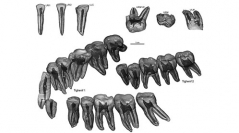

 Comptes Rendus Palevol
12 (5) - Pages 293-304
Comptes Rendus Palevol
12 (5) - Pages 293-304The early Middle Pleistocene human fossil assemblage from Tighenif, Algeria, likely samples some among the earliest representatives of the Homo heidelbergensis morph. A previous study of three deciduous molars from this assemblage revealed an inner structural signature (crown tissue proportions and enamel thickness topography) roughly approximating the modern human figures. By using advanced techniques of microtomographic-based 3D virtual imaging and quantitative analysis, we significantly extend here the currently available record to 22 permanent teeth, mostly from the mandibular dentition, and provide the first detailed description of the structural condition characterizing this North African deme near the Lower-Middle Pleistocene boundary. Together with a certain degree of individual variation, the teeth of Tighenif exhibit a structural pattern combining primitive, derived, and unique features. The lower molars display a set of enamel-dentine junction nonmetric traits more frequently found in recent humans than in Neanderthals, but also a blend of Neanderthal- and modern-like characteristics in terms of structural conformation and crown tissue proportions. They also exhibit relatively large pulp cavities, with a rather high root bifurcation and well-separated pulp canals, a pattern more closely approximating the condition reported for Late Pleistocene Aterians.
Tighenif, Permanent teeth, Structural morphology, Tissue proportions, Early Middle Pleistocene, H. heidelbergensis, Algeria